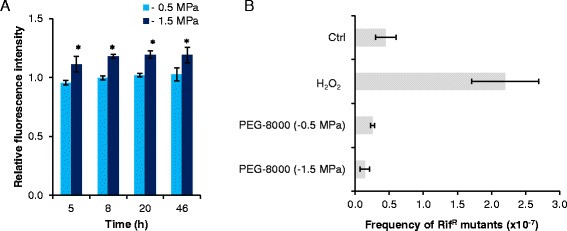Fig. 6.

Induction of the DNA-damage inducible PPP3901 bioreporter and frequency of mutations conferring rifampicin resistance in P. putida mt-2 following exposure to matric stress. a Induction of a chromosomal PPP3901-gfp fusion in P. putida mt-2 exposed to mild matric stress of −0.5 MPa or extensive matric stress of −1.5 MPa 5–46 h post stress induction. Data represent average fluorescence intensity from cells exposed to matric stress normalized to average fluorescence intensity from control cells.b Occurrence of clones conferring resistance to rifampicin (100 μg mL−1) normalized to the number of CFU on LB agar without rifampicin following a 72-h incubation with either H2O2, matric stress (−0.5 MPa or −1.5 MPa), or without any stress inducer (control, Ctrl). Data are mean values ± S.D. (n = 3). Asterisks (*) indicate mean values from treated cultures that are significantly (P < 0.05) higher than mean values from Ctrl cultures
